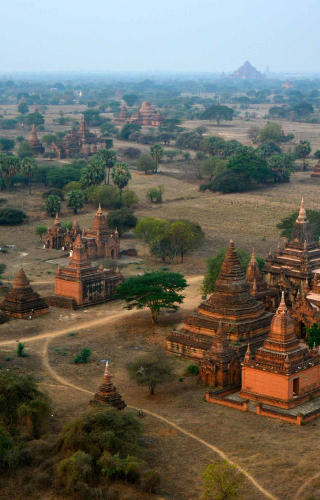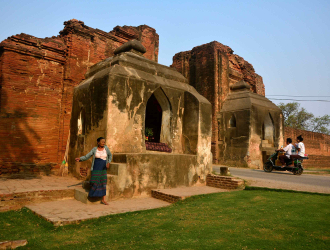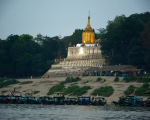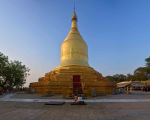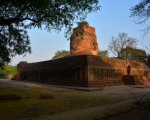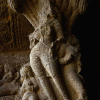Two ancient civilisations which has shaped the history of South East Asia are China and India. India’s impact in the region was civilisational and cultural, achieved mostly through trade, education, arts and pilgrimage; rarely —if ever— through conquest. India dominated maritime routes across the Bay of Bengal and Indian Ocean through ports in Bengal, Kalinga, Andhra and the deep South. Buddhism, which had its birthplace in the Gangetic plains in India and received patronage from powerful empires in the region, spread to Burma, Sumatra, Sri Lanka and the Malayan Peninsula. Hindu culture, too, gained footholds in Java, Cambodia, Bali, Thailand and Vietnam.
China’s interest in Southeast Asia—which it could access through the South China Sea and Yunnan—was more political. China saw itself as a hegemon, and successive empires claimed suzerainty over the independent polities of Southeast Asia. Occasionally the Chinese would militarily intervene to enforce tributary status, which would result in periods of chaos in these regions.
In South East Asia, the only country which was geographically close to both China and India was Burma (modern Myanmar). From India, it was separated by Arakan (modern Rakhine), which had maritime links with India and Arabia. The kingdom of Nanzhao, today’s Yunnan, buffered Burma from the Tang empire in China and Tibet. Indian culture, both Hindu and Buddhist, flourished in Thaton, a Mon kingdom around the delta of the Sittang River, in southern Burma. This land, recorded as Suvarnabhumi in edicts of Emperor Ashoka, was an early entry point for Buddhism in mainland Southeast Asia, where Ashoka had dispatched a proselytising mission from India.
Though Burma was settled since prehistoric times, the earliest known civilisation in Upper Burma is identified with the Pyu culture. The Pyu people built high walled cities from the second century BC onwards, starting at Beikthano. This was followed by other cities at Tagaung, Binnaka, Maingmaw, Sri Kshetra and Halin. These Pyu city-sates are mentioned in the memoirs of both Xuang Zhang and I-Ching, Chinese monks who visited India in the seventh century.
From the eighth century, the Pyu cities came under attack from Nanzhao. This period also saw migration of the Mranma (Bamar) people from Yunnan, who would eventually dominate Burma. Weakened by repeated invasions, the Pyu city-states declined by the late ninth century. Though they had flourished for a thousand years, very little remain of the Pyu-era cities now. At Sri Kshetra (modern Prome), the best preserved of the sites, bulbous stupas, foundation of city walls and a few brick monuments indicate significant influence from India.
In 849 CE, a new power emerged at Arimaddanapura in Central Burma, strategically located on the banks of the Irrawaddy River. Over the next two centuries it became the capital of Pagan (modern Bagan); the first Burmese Empire. Though a new political entity, Pagan was more a continuation of Pyu culture which had been slowly assimilated by the Mranma people. This is reflected in the bulbous Bupaya and Ngakywenadaung stupas of Old Bagan, which are identical in shape to Pyu-era stupas at Sri Kshetra.
Pagan’s golden age started during the reign of Anawratha, who became king in 1044 CE. Anawratha focused on increasing agricultural produce by investing in irrigation projects. This paid off and the Kyaukse plains became the granary of Upper Burma and greatly enriched the kingdom, providing stable revenue to the empire. After consolidating his economic power, Anawratha embarked on campaigns to expand Pagan’s frontiers which has shaped the boundaries of modern Myanmar.
In 1057 CE, Anawratha invaded the Mon kingdom at Thaton, and brought back elephants loaded with Tripitaka manuscripts (Buddhist scriptures), which he housed at Pitaka Taik. Anwaratha imprisoned Manuha, the last ruler of Thaton, and brought him to Pagan and held him and his wife captive at Nan Paya. His large entourage settled in Pagan, thereby enriching Pagan with Mon culture, which was seen as a more advanced culture by the ruling elite at Pagan. This legacy is reflected in Pagan’s innumerable Mon-styled monuments. At Pagan, Manuha commissioned the Manuha Paya, still in active use.
A devout Buddhist, Anwaratha commissioned projects to promote Theravada Buddhism. His outstanding legacy is the Shwezigon Pagoda, built to enshrine a replica of Buddha’s tooth relic sent from Sri Lanka. He also built the Shwesandaw stupa. In both these stupas, the bulbous form of older stupas was changed to a new bell shape; the tapering finial reached great heights, which was achieved by placing the stupas on top of several levels of receding terraces, giving it a pyramidal form. This became a template for all later Burmese stupas.
At Pagan, the colossal stupas —which had a solid core— were relatively easy to build. The temples were more complex and were built in ‘gu’ style, which mimicked dark, cave-like environment of early Buddhist rock-cut architecture in India. Pagan architects limited the use of stone, instead relying on bricks as main building material. Brick was extensively used at older Pyu cities and in the great mahaviharas (Nalanda, Vikramshila, Somapura) of the Pala Empire in Bengal, and at Anuradhapura, in Sri Lanka, regions that had a long history of contact with Pagan. However, to their sole credit, Burmese engineers independently developed the technique of making load-bearing walls, supported by vaults and arches, which allowed construction of mega-buildings with the capacity to bear immense pressure and survive earthquake damage.
Anawratha died in 1077 CE, and after a brief rule by his son Saw Lu, was succeeded by another son, Kyanzittha, in 1084 CE. Kyanzittha commissioned Ananda Phaya, considered the finest proportioned temple at Pagan. He also sent a team to restore the Mahabodhi Temple at Bodhgaya in India. A keen patron of Mon culture, he built the Mon-style temples Abeyadana and Nagayon. His son, Rajakumar, built Gubyaukgyi temple and adjoining Myazedi pagoda, where he installed the Myazedi inscription written in four languages (Burmese, Pyu, Mon and Pali).
Kyanzittha’s successor Alaungsithu (r. 1112–67 CE), commissioned Shwegugyi and Thatbyinnyu. The next king, Narathu (r. 1167–71 CE) built Pagan’s largest monument, Dhammayangyi. Monumental temple construction continued under Narapathisithu (r. 1174–1211 CE), who sponsored Gawdawpalin, Sulamani and Dhammayazika, and his son Nadaungmya (r. 1211–19 CE), who built Htilominlo and the Mahabodhi Temple, modelled on the original Mahabodhi Temple at Bodhgaya, in India. From the early thirteenth century, Pagan entered a period of slow decline and the last great monument completed was Mingalazedi, built by Narathihapate (r. 1256–87 CE).
In 1287 CE, Pagan was occupied by the Mongol armies of the Great Khan, Kublai, and the last king of Pagan, Narathihapate, fled Bagan was later assassinated by his son. In the aftermath of the Mongol invasion, the empire disintegrated and Pagan was abandoned, never to rise again. The royal palaces, monasteries and homes of civilians, which were made in thatch, bamboo and timber, rotted away over time while the stone and brick structures were mostly destroyed in earthquakes, the latest striking in in 2016, causing extensive damage. On July 6, 2019, the surviving 2000 monuments at Pagan was officially declared a World Heritage Site by UNESCO.
